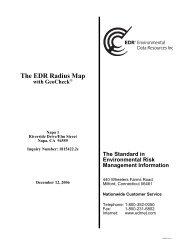1 - the Envirostor
1 - the Envirostor
1 - the Envirostor
You also want an ePaper? Increase the reach of your titles
YUMPU automatically turns print PDFs into web optimized ePapers that Google loves.
1.6, Section 07115, Subsection 1.4 and 1.5, specific methodology for liner<br />
placement field scanning, and placement of boots for monitoring wells,<br />
telephone poles, guide wires, fence posts, and o<strong>the</strong>r structures penetrating<br />
<strong>the</strong> liner were prepared by Canonie with cooperation and information from<br />
Nilex. This information was submitted to DHS two weeks before liner<br />
installation and is included as Appendix D.<br />
Upon delivery, <strong>the</strong> HDPE liner was stored in <strong>the</strong> area shown on Figure 4.<br />
When it was determined that <strong>the</strong> drum yard subgrade was completed, <strong>the</strong> liner<br />
was removed from <strong>the</strong> storage area and placed onto <strong>the</strong> drum yard using an<br />
extended arm crane. The 1 iner was rolled out and placed into position by<br />
laborers. A Nilex field technician <strong>the</strong>n fused <strong>the</strong> sheets of HDPE toge<strong>the</strong>r<br />
as per <strong>the</strong> working details that Nilex had provided. Nilex suggested that a<br />
better seal around <strong>the</strong> monitoring wells could be achieved if <strong>the</strong> concrete<br />
utility boxes were replaced with sono tubes. This would allow <strong>the</strong><br />
performed pipe boots to be used instead of using a field weld. This method<br />
was determined to be acceptable by Canonie, DHS, and CH2M HILL so long as<br />
<strong>the</strong> utility boxes were replaced and accessiblity to <strong>the</strong> monitoring wells<br />
maintained. Plans were made for utility box replacement so that <strong>the</strong> sono<br />
tubes could be used.<br />
Field vacuum testing and laboratory destructive testing of <strong>the</strong> liner seams<br />
were performed. Any seams that proved to be inadequately welded were re-<br />
welded and tested again to insure <strong>the</strong>ir integrity.<br />
2.6.2 Concrete Placement<br />
The placement of <strong>the</strong> concrete curb and catch basin conformed to Section<br />
03300 of <strong>the</strong> Construction Specifications and as is shown on <strong>the</strong><br />
construction drawings. The concrete curb was placed and allowed to cure<br />
five days before placement of final subsurface cover material and HDPE<br />
liner. The existing curb around <strong>the</strong> sump was removed and <strong>the</strong> sump<br />
backfilled with concrete so that <strong>the</strong> newly constructed curb could be<br />
extended over <strong>the</strong> sump. After <strong>the</strong> curb had been cured, <strong>the</strong> HDPE liner was<br />
fastened to <strong>the</strong> curb with Hilti concrete anchorages.




